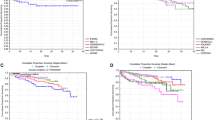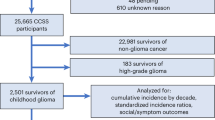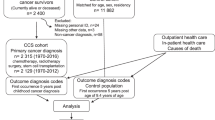Abstract
Currently, in the US and Western Europe about 75% of children diagnosed with cancer survive at least 5 years and most survivors are cured. Unfortunately, survivors are at an increased risk of a range of adverse health outcomes compared with that expected from the general population. Large-scale studies of mortality occurring beyond 5-year survival show that the majority of the deaths in the initial decade are because of recurrent tumors. Thereafter, other causes of death that occur increasingly including second malignant neoplasms, cardiac deaths and pulmonary deaths. During the past 25 years, research has focused on estimating the risks of such long-term 'effects' of childhood cancer and its treatment. Studies have examined how risks vary in relation to a range of factors that include treatment exposures, age at treatment, type of childhood cancer, duration of follow-up, and factors that may genetically predispose a survivor to particular complications. This information is critical to counsel survivors and their families in relation to long-term risks and identify specific groups of survivors who are at particularly high risk—with a view to earlier diagnosis or intervention and provide the means of assessing potential benefits and risks of different proposals for future treatment protocols.
This is a preview of subscription content, access via your institution
Access options
Subscribe to this journal
Receive 12 print issues and online access
$209.00 per year
only $17.42 per issue
Buy this article
- Purchase on Springer Link
- Instant access to full article PDF
Prices may be subject to local taxes which are calculated during checkout
Similar content being viewed by others
References
Gatta G et al. (2002) Childhood Cancer Survival in Europe and the United States. Cancer 95: 1767–1772
Kroll M et al. Childhood Cancer – UK. In Cancer Research UK Monograph, Cancer Research UK, in press
Robison LL et al. (2002) Study design and cohort characteristics of the Childhood Cancer Survivor Study: A multi-institutional collaborative project. Med Pediatr Oncol 38: 229–239
Taylor A et al. (2004) Long-term follow-up of survivors of childhood cancer in the UK. Pediatr Blood Cancer 42: 161–168
Hawkins MM (1989) Long term survival and cure after childhood cancer. Arch Dis Child 64: 798–807
Hawkins MM et al. (1990) Late deaths after treatment for childhood cancer. Arch Dis Child 65: 1356–1363
Robertson CM et al. (1994) Late deaths and survival after childhood cancer: implications for cure. BMJ 309: 162–166
Mertens AC et al. (2001) Late mortality experience in five-year survivors of childhood and adolscent cancer: The Childhood Cancer Survivor Study. J Clin Onc 19: 3163–3172
Möller TR et al. (2001) Decreasing late mortality among five-year survivors of cancer in childhood and adolescence: A population-based study in the Nordic countries. J Clin Oncol 19: 3173–3181
Olsen JH et al. (1993) Second malignant neoplasms after cancer in childhood or adolescence. BMJ 307: 1030–1036
Hawkins MM et al. (1987) Incidence of second primary tumors among childhood cancer survivors. Br J Cancer 56: 339–347
Neglia JP et al. (2001) Second malignant neoplasms in five-year survivors of childhood cancer: Childhood Cancer Survivor Study. J Natl Cancer Inst 93: 618–629
Wong FL et al. (1997) Cancer incidence after retinoblastoma: radiation dose and sarcoma risk. JAMA 278: 1262–1267
Moll AC et al. (2001) Second primary tumors in hereditary retinoblastoma: A register-based study, 1945-1997: is there an age effect on radiation-related risk? Opthalmology 108: 1109–1114
Hawkins MM et al. (1996) Radiotherapy, alkylating agents and risk of bone cancer after childhood cancer. J Natl Cancer Inst 88: 270–278
Fletcher O et al. (2004) Lifetime risks of common cancers among retinoblastoma survivors. J Natl Cancer Inst 96: 357–363
Draper GJ et al. (1986) Second primary neoplasms in patients with retinoblastoma. Br J Cancer 53: 661–671
Metayer C et al. (2000) Second cancers among long-term survivors of Hodgkin's disease diagnosed in childhood and adolescence. J Clin Oncol 18: 2435–2443
Sankila R et al. (1996) Risk of subsequent malignant neoplasms among 1,641 Hodgkin's disease patients diagnosed in childhood and adolescence: a population-based cohort study in the five Nordic countries. Association of the Nordic Cancer Registries and the Nordic Society of Pediatric Hematology and Oncology. J Clin Oncol 14: 1442–1446
Wolden SL et al. (1998) Second cancers following pediatric Hodgkin's disease. J Clin Oncol 16: 536–544
Bhatia S et al. (2003) High risk of subsequent neoplasms continues with extended follow-up of childhood Hodgkin's disease: report from the Late Effects Study Group. J Clin Oncol 21: 4386–4394
Travis LB et al. (2003) Breast cancer following radiotherapy and chemotherapy among young women with Hodgkin disease. JAMA 290: 465–475
van Leeuwen FE et al. (2003) Roles of radiation dose, chemotherapy and hormonal factors in breast cancer following Hodgkin's disease. J Natl Cancer Inst 95: 971–980
Hinkle AS et al. (2004) Cardiotoxicity caused by chemotherapy. In Late Effects of Childhood Cancer, 85–100 (Eds WHB Wallace and D Green) London: Arnold Publishers
Levitt GA and Saran FH (2004) Radiation damage. In Late Effects of Childhood Cancer, 101–113 (Eds WHB Wallace, D Green) London: Arnold Publishers
Giantris A et al. (1998) Anthracycline-induced cardiotoxicity in children and young adults. Critical Reviews Oncol/Hematol 27: 53–68
Krischer JP et al. (1997) Clinical cardiotoxicity following anthracycline treatment for childhood cancer: The Pediatric Oncology Group experience. J Clin Oncol 15: 1544–1552
Grenier MA and Lipshultz SE (1998) Epidemiology of anthracycline cardiotoxicity in children and adults. Semin Oncol 25 (Suppl): S72–S85
Green DM et al. (2001) Congestive heart failure after treatment for Wilms' tumor: A report from the National Wilms' Tumor Study Group. J Clin Oncol 19: 1926–1934
Wexler LH et al. (1996) Randomized trial of the cardioprotective agent ICRF-187 in pediatric sarcoma patients treated with doxorubicin. J Clin Oncol 14: 362–372
Lipshultz SE et al. (2004) The effect of dexrazoxane on myocardial injury in doxorubicin-treated children with acute lymphoblastic leukemia. N Engl J Med 351: 145–153
Kremer LCM and Caron HN (2004) Anthracycline cardiotoxicity in children. N Engl J Med 351: 120–121
Hancock SL et al. (1993) Cardiac disease following treatment of Hodgkin's disease in children and adolescents. J Clin Oncol 11: 1208–1215
Darzy KH et al. (2004) Growth and neuroendocrine consequences. In Late Effects of Childhood Cancer, 189–211 (Eds WHB Wallace and D Green) London: Arnold Publishers
Swerdlow AJ et al. (2002) Risk of cancer in patients treated with human pituitary growth hormone in the UK, 1959-85: a cohort study. Lancet 360: 273–277
Sklar CA et al. (2002) Risk of disease recurrence and second neoplasms in survivors of childhood cancer treated with growth hormone: a report from the Childhood Cancer Survivor Study. J Clin Endocrinol Metab 87: 3136–3141
Rose SR et al. Diagnosis of hidden central hypothyroidism in survivors of childhood cancer. J Clin Endocrinol Metab 84: 4472–4479
Rose SR (2001) Cranial irradiation and central hypothyroidism. Trends Endocrinol Metab 12: 97–104
Sklar C et al. (2000) Abnormalities of the thyroid in survivors of Hodgkin's disease: data from the Childhood Cancer Survivor Study. J Clin Endocrinol Metab 85: 3227–3232
Byrne J et al. (1987) Effects of treatment on fertility in long term survivors of childhood or adolescent cancer. N Engl J Med 317: 1315–1321
Critchley HOD et al. (2004) Ovarian and uterine function and reproductive potential. In Late Effects of Childhood Cancer, 225–238 (Eds WHB Wallace and D Green) London: Arnold Publishers
Thomson AB et al. (2004) Testicular function. In Late Effects of Childhood Cancer, 239–256 (Eds WHB Wallace and D Green) London: Arnold Publishers
Wallace WHB, Green D (Eds) (2004) In Late Effects of Childhood Cancer, London, Arnold Publishers
Author information
Authors and Affiliations
Corresponding author
Ethics declarations
Competing interests
The author declares no competing financial interests.
Rights and permissions
About this article
Cite this article
Hawkins, M. Long-term survivors of childhood cancers: what knowledge have we gained?. Nat Rev Clin Oncol 1, 26–31 (2004). https://doi.org/10.1038/ncponc0020
Received:
Accepted:
Issue Date:
DOI: https://doi.org/10.1038/ncponc0020
This article is cited by
-
Late somatic sequelae after treatment of childhood cancer in Slovenia
BMC Research Notes (2012)
-
Validation of modified forms of the PedsQL generic core scales and cancer module scales for adolescents and young adults (AYA) with cancer or a blood disorder
Quality of Life Research (2009)
-
Preventing or reducing late side effects of radiation therapy: radiobiology meets molecular pathology
Nature Reviews Cancer (2006)
-
Does radiotherapy to the head, neck or upper thorax for childhood cancer increase the risk of later thyroid cancer?
Nature Clinical Practice Oncology (2005)



